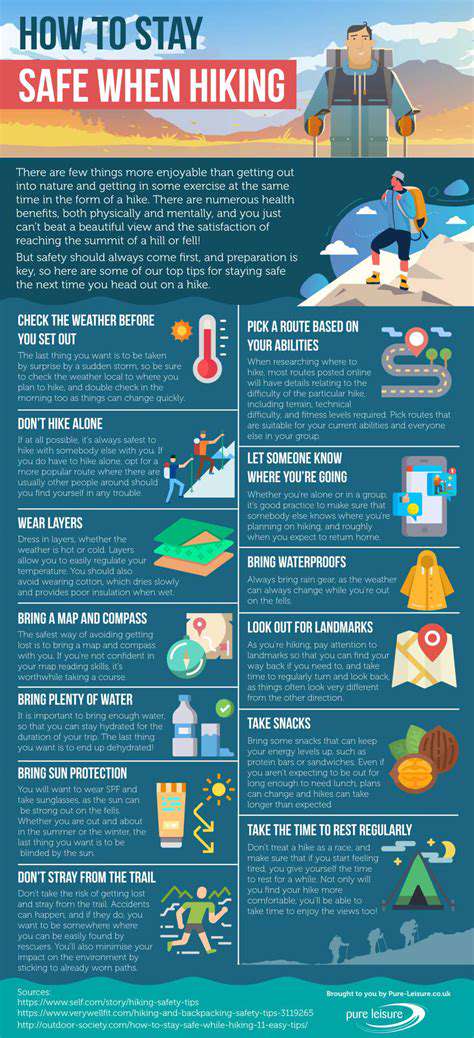Hiking Safety Tips for Solo Trekkers

Pre-Trek Preparation: Essential Steps
Proper groundwork makes all the difference when preparing for a trek. It's not just about throwing gear into a backpack - it's about intimately knowing the landscape, anticipating weather shifts, and honestly assessing your physical limits. Meticulous planning transforms potential hazards into manageable challenges while amplifying your enjoyment. Study the trail's elevation profile, typical weather patterns during your planned dates, and any required permits. This knowledge lets you prepare effectively and creates a more fluid journey.
Physical conditioning deserves special attention. Hiking demands sustained exertion, so consistent training prevents injuries and builds the endurance needed to handle varied terrain. Blend cardiovascular workouts like trail walking, jogging, or cycling with targeted strength exercises for legs, core, and back muscles. Don't overlook nutrition and hydration - they're the fuel that powers your adventure. Practice drinking regularly during training hikes to condition your body for the trail's demands.
Gear Essentials and Logistics
Your equipment choices directly affect comfort and safety. Invest in quality hiking boots, weather-appropriate clothing layers, and a properly fitted backpack. The right gear selection can mean the difference between misery and enjoyment on the trail. Match your equipment to expected conditions - consider temperature ranges, precipitation likelihood, and trip duration. Durability and functionality should guide every purchase decision. A comprehensive checklist prevents forgotten essentials.
Handling logistics beforehand prevents last-minute scrambling. Arrange transportation, secure necessary permits, and establish emergency protocols. A well-structured plan for these elements removes unnecessary stress and keeps your focus on the experience. Research local regulations regarding camping and backcountry access. Planning food and water resupply points along your route saves valuable time and energy.
Always share your itinerary with someone reliable. Providing detailed plans to a contact who can monitor your progress and initiate emergency response if needed adds a crucial safety net. This becomes particularly vital for solo trekkers.
Anticipate potential challenges like sudden weather shifts, gear failures, or route delays. Preparing contingency plans enhances your ability to adapt calmly when situations change unexpectedly.
Study the trail's difficulty rating and research specific hazards like wildlife activity or technical sections. Foreknowledge of challenges allows proper preparation and risk mitigation.
Navigating the Trail: Staying Aware and Prepared
Understanding the Terrain and Conditions
Venturing into unknown wilderness, especially alone, requires deep familiarity with the trail's characteristics. Beyond elevation changes and obvious hazards like cliffs or boulder fields, stay attuned to evolving weather patterns. Checking forecasts immediately before departure and remaining prepared for rapid weather shifts could save your life. Proper preparation transforms potential dangers into manageable challenges. Trail markers and topographic maps become your best friends - study them thoroughly before setting out.
Develop terrain awareness by noting distinctive landmarks and understanding how the landscape transitions along your route. Underestimating trail difficulty leads to unnecessary risk, so honestly assess conditions before committing to any section.
Recognize warning signs in the environment. Avoid unstable areas like loose scree or slick surfaces. When facing uncertain terrain, retreating often proves wiser than pushing forward. Your safety always outweighs any summit goal.
Essential Gear and Safety Procedures
The right equipment significantly enhances safety and enjoyment. Always carry reliable navigation tools - maps and compass (with knowledge to use them) plus GPS as backup. A comprehensive first-aid kit with bandages, antiseptics, pain medication, and blister care should be easily accessible.
Communication planning is non-negotiable for solo hikers. Share detailed plans including route, timeline, and emergency contacts with someone reliable. Consider carrying a PLB or satellite messenger in areas with spotty cell coverage - these devices can summon help when needed most.
Pack ample water and calorie-dense snacks to maintain energy and prevent dehydration. Always carry extra supplies to accommodate unexpected delays. Layered clothing systems adapt to changing conditions throughout the day.
Staying Safe During Wildlife Encounters

Wildlife Encounters: Preparation is Key
Before entering wildlife habitats, research local species behaviors thoroughly. Understanding animal psychology and threat displays dramatically reduces dangerous situations. Knowledge transforms fear into respectful coexistence. Learn species-specific warning signs and appropriate responses.
Carry species-appropriate deterrents like bear spray where needed, and practice deployment beforehand. Maintain constant environmental awareness and respect animals' personal space.
Respecting Wildlife Habitats
Most conflicts arise from human encroachment. Staying on established trails minimizes ecological impact and reduces surprise encounters. Practice Leave No Trace principles rigorously in wildlife areas.
Never feed wildlife intentionally or through careless food storage. Human food alters natural behaviors and creates dangerous dependencies. Store all food securely and pack out all waste.
Recognizing Warning Signs
Animals communicate discomfort through body language and vocalizations. Learn to interpret these signals - they often precede aggressive actions. Defensive postures like raised hackles or hissing indicate immediate retreat is necessary.
Maintaining a Safe Distance
Respect varies by species but always err on caution's side. Use optics for observation rather than approaching. Avoid areas where animals are feeding, resting, or nurturing young.
Responding to Potential Threats
If facing large mammals, make yourself appear larger while avoiding direct eye contact. Move slowly sideways rather than turning your back. For snakes, freeze then retreat carefully without sudden movements.
Knowing When to Leave
Discretion is the better part of valor in wildlife encounters. If situations feel unsafe, retreat immediately without hesitation. Never risk confrontation for photos or curiosity.
Emergency Preparedness: Knowing What to Do When Things Go Wrong
Understanding Potential Hazards
Hiking's rewards come with inherent risks. Injuries, weather emergencies, and equipment failures can occur unexpectedly. Recognizing potential dangers like steep terrain, rapidly changing weather, and wildlife activity enables proactive safety measures. Preparation and situational awareness form the foundation of safe adventures.
Essential Gear and Supplies
Packing for Success
Thoughtful packing balances preparedness with practicality. Essentials include navigation tools, illumination, first-aid supplies, repair kits, and emergency shelter. Tailor your kit to trip duration and environmental conditions. Include sun protection, insect repellent, and appropriate clothing layers.
Navigating the Trail
Thorough pre-hike research prevents many emergencies. Study current trail conditions and weather forecasts. Always inform someone of your detailed plans including route and expected return. Carry multiple navigation methods and know how to use them.
First Aid and Injury Prevention
Basic first aid knowledge is essential. Customize your kit with supplies for common trail injuries. Proper footwear prevents many problems - break in boots beforehand and address hot spots immediately.
Weather Awareness and Contingency Planning
Monitor weather trends before and during your hike. Develop alternate routes and know shelter locations. Understand signs of impending storms and hypothermia symptoms.
Emergency Procedures and Communication
Learn emergency signaling techniques and device operation. Carry multiple communication methods considering coverage limitations. Know local emergency numbers and rescue protocols.








![Family Travel Itinerary Ideas [Worldwide Destinations]](/static/images/27/2025-05/ExoticAsianExplorations3AAncientWondersandVibrantCultures.jpg)

![Tips for Flying with Kids [Stress Free Guide]](/static/images/27/2025-05/PlanningAheadforaSmoothFlight3APre-TripPreparation.jpg)
